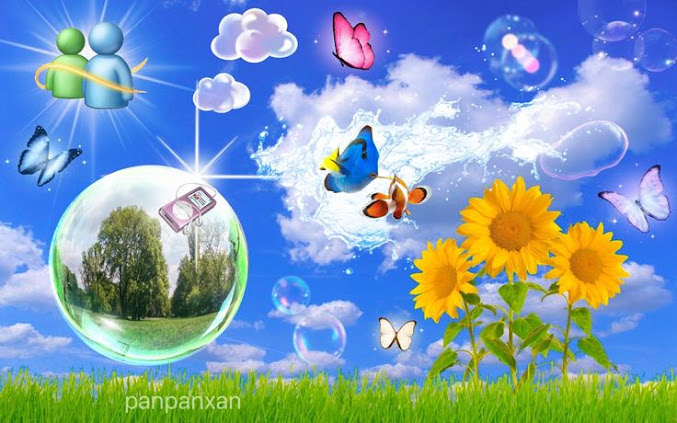Introduction
Anemoia is nostalgia for a time you have never experienced; it also means having feelings for something that we don't have now but would like to have, such as Frutiger Aero. So, I am showing my love for this feeling through my work, trying to show viewers what I see when I feel such emotions. But to me, the state of anemoia is comforting, as it was triggered by revisiting places I visited when I was a young child, such as vividly remembering the children's wing of a hospital waiting for a check-up with all the fish on the walls and hanging from the ceiling. My comfort zones contain the details mentioned above, as well as thinking back at things I had used, played with or watched as a young child, as it brings back good memories of times that make me remember doing so.
This is how I became interested in this aesthetic. My versions of this forgotten aesthetic can bring back some memories to viewers who remember experiencing it in the past, even if they see it in passing, like inside a shop or on some software. I will explore this aesthetic by recreating my own versions using images of places I would see daily. I will also show the absence of people, thus giving them an immaculate look, as humans extract natural resources, making areas look unclean and unkempt. So, my pieces of art should look pure and untouched.
Artist Research
Frutiger Aero is named after Adrian Frutiger (who created the Frutiger fonts commonly used alongside Frutiger Aero) and Windows Aero (the UI theme of Windows Vista/7), which spread outward and influenced many other companies' design choices during the era. However, Sofi Lee coined the term Frutiger Aero in 2017 as a combination of Aero and the Frutiger typeface, which was popular with corporate materials of the time.
(an example of Frutiger Aero, Pinterest)
Research on the topic
Web 1.0, 2.0, and 3.0 are classic terms used to describe the evolution of the World Wide Web. Each iteration has brought new capabilities and changes to how we interact with the web.
1.0 emerged in the 1990s and was primarily used for information sharing and retrieval. Websites were static and mainly consisted of text and images. Users could only view and read the information but not interact with it. But everything changed after the second wave of internet evolution.
Web 2.0, which emerged in the early 2000s, introduced interactivity and user-generated content. With its changes, websites became more dynamic and allowed user participation through blogs, forums, and social networking features.
But soon, Web 3.0 made headlines as the "Semantic Web". It is said to be the next evolution of the World Wide Web. The concept behind Web 3.0 is to make the web more intelligent by using technology such as artificial intelligence, machine learning, and natural language processing. This would allow computers to understand and interpret web content in a more human-like way, making it easier for people to find the information they need. However, Web 3.0 is still under development, but some early examples include virtual reality, augmented reality, and voice-enabled search.
Artist Research
"James Casebere, born in 1953, is an artist with a similar style to this aesthetic. He grew up outside of Detroit and studied with Siah Armajani as an undergraduate at the Minneapolis College of Art and Design and John Baldessari as a graduate student at Cal Arts.
For over 40 years, Casebere has built and photographed architecturally based models which explore the relationship between sculpture, photography, architecture, and film. Starting with Sonsbeek '86, in Arnhem, Holland, through 1992, Casebere made large-scale sculptural installations.
His work is in the collections of and has been shown at major museums around the world, including the Museum of Modern Art, the Solomon R. Guggenheim Museum, and the Whitney Museum (New York); the Tate Gallery (London); the Los Angeles County Museum of Art (Los Angeles); and many others. He has had solo shows at the Musée d'art contemporain de Montréal (Canada); Centro Galego de Arte Contemporánea (Spain); Museum of Modern Art Oxford (UK); the Cleveland Museum of Contemporary Art (Ohio); the Indianapolis Museum of Fine Arts (Indiana); and other museums.
In 2016, his work was the subject of a major retrospective at the Haus der Kunst in Munich, Germany and has been included in exhibitions highlighting the work of what is now widely regarded as the Pictures Generation, the title of a 2009 exhibition at the Metropolitan Museum of Art in New York. Casebere receives three fellowships from the National Endowment for the Arts, three from the New York Foundation for the Arts and one from the Guggenheim Foundation. In April 2019, he was awarded the Abigail Cohen Rome Prize through the American Academy in Rome."
The image below is by Casebere, called 'Yellow House on Water', made in 2018. It shows a simple yellow house with no windows or doors, a very high doorframe, and a railless staircase to one of the rooms. This building is in front of a group of mountains that are silhouetted due to the dark, overcast clouds, yet its reflection is seen in the water in front of it, distorted by the water's surface ripples.
This has inspired me to create my own by taking a picture of some exterior or interior and editing or redrawing them to make them look white and clean so that I can add some frutiger aero aspects into it, such as glassy looking bubbles, significant things in a smaller space, like a giant butterfly in an average room. I have always been intrigued by retro aesthetics such as Frutiger Aero because this style reignites memories and stories of a particular time, making it unique. But these aesthetics give me a sense of anemoia.
Images that I took for some inspiration








